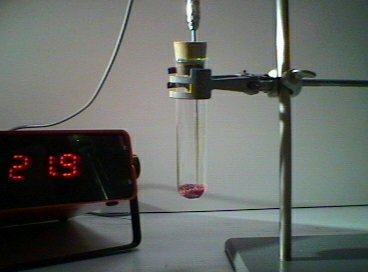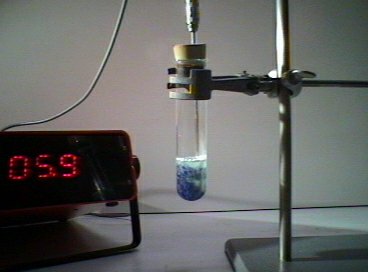

| 1. |  |
2. |  |
| Cobalt (II) chloride before the addition of thionyl chloride | Cobalt (II) chloride 7 minutes after the addition of thionyl chloride |
| Photo 1: | Experimental setup: A test tube with 4 g violet cobalt (II) chloride is equipped with a temperature sensor. Initial temperature: 21.9 °C. |
| Photo 2: | 20 ml thionyl chloride is added. Within 7 minutes the temperature sinks from 16 °C to 5.9 °C. Gas is given off and the color changes from violet to blue:
[CoCl2. 6 H2O] + 6 SOCl2 > CoCl2 + 12 HCl + 6 SO2
violet blue The water of crystallization of the cobalt chloride reacts with the thionyl chloride and produces hydrochloric acid and sulfur dioxide. The reaction is endothermic, i.e. it takes place by absorbing heat energy from the environment (temperature lowering). The reaction enthalpy is positive. Nevertheless, the reaction occurs spontaneously given that a large amount of gas forming products develop and thus the disorder of the system increases. Cobalt chloride is used in the so-called "blue gel" (blue silica gel). The color change from blue to violet indicates the dessicating power of the silica gel has been exhausted and that it must be renewed. |
| Safety Precautions: | Since hydrogen chloride is produced, reactions with thionyl chloride should be performed in a fume hood. Possible residues can safely be dipsosed of by adding ice. |